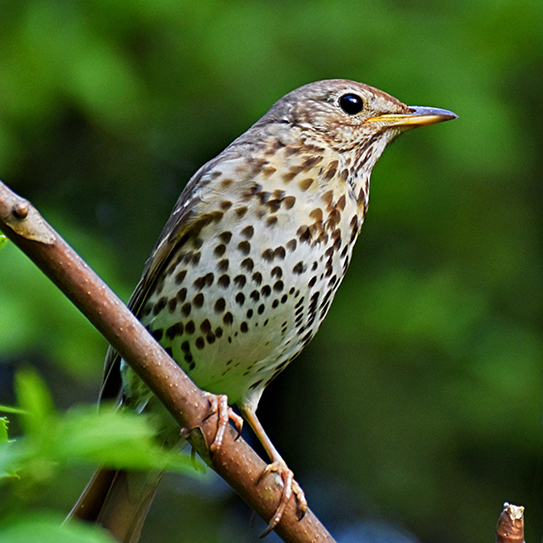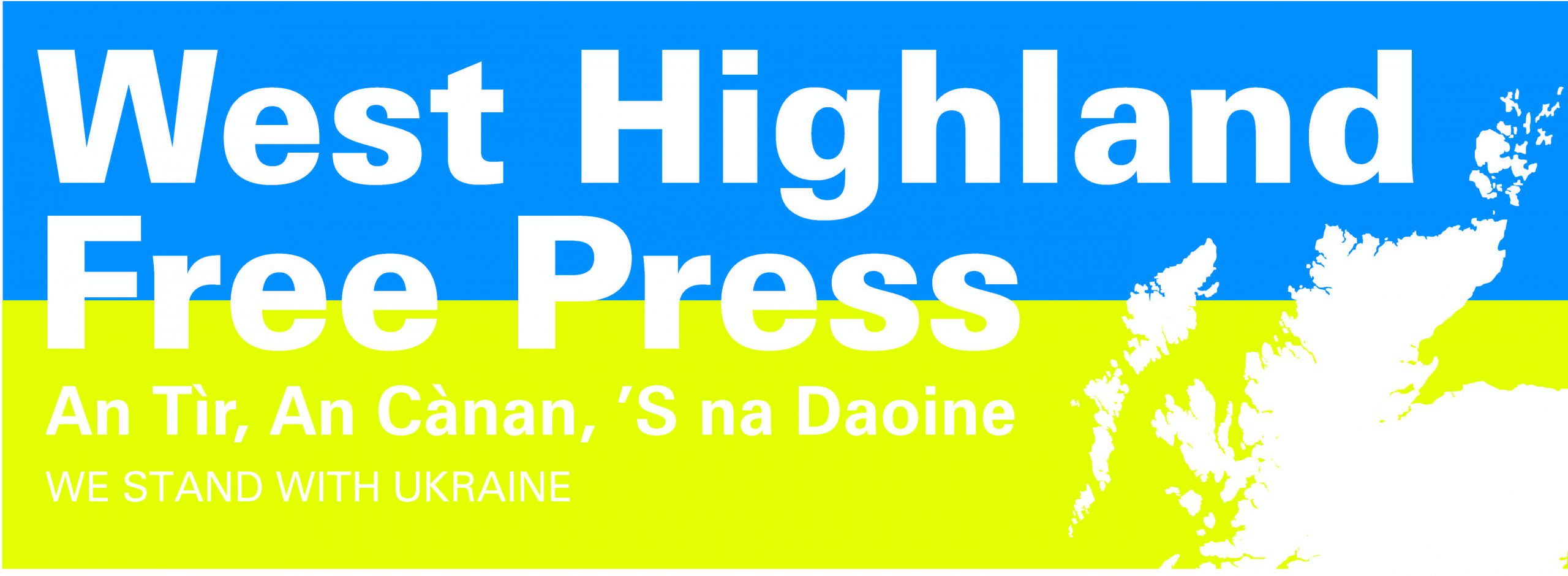
Annie Johnston with John Lorne Campbell, courtesy of the Margaret Faye Show Collection, NTS
This month’s Tobar an Dualchais / Kist O Riches contribution is from Mairi McFadyen. Mairi used to teach at University of Edinburgh working with students to explore the creative voices in the School of Scottish Studies Archives. She is now based in the Highlands working as a freelance ethnologist and writer. Here, she reflects on our ecological crises through the lens of birds and birdsong
Our fascinating feathered friends and their songs have inspired art, music, myth and folklore the world over – a truth reflected locally in the many recordings to be found on Tobar an Dualchais / Kist O Riches.
When it comes to the environment, the birds are our measure, our meter. They mark the coming and going of the seasons, pollinate plants and disperse seeds, help forests flourish. Their presence – and absence – is an insight into the health of our world.
In our time of ecological crises, there are far fewer birds than there used to be. Changing climate and shifting weather patterns have already affected a third of bird species in the UK, with migratory birds hit the hardest. This loss affects us all in ways we might not even imagine.
American biologist Rachel Carson’s book Silent Spring (1962) is considered by many to be the most important environmental book of the 20th century, raising awareness of the effects of pesticide pollutants on the biosphere and igniting the wider environmental movement. It takes its title from the unnatural quiet settling on a world that is losing its birds:
“It was a spring without voices. In the mornings, which had once throbbed with the dawn chorus of robins, catbirds, doves, jays, and wrens, and scores of other bird voices, there was now no sound”
This ‘silent spring’ is a world away from the rich descriptions of abundant wildlife to be found in Gaelic nature poetry. The song Oran Bràigh Rùsgaich, composed in 19th century Edinburgh by John MacDougall of Glen Urquhart, describes in nostalgic and beautiful detail – and with marked reference to the birds – a place he longs for but may never return to. The version here is sung by Angus Nicolson, recorded on reel-to-reel by Calum MacLean in 1952 (TaD ID: 1369):
Cha b’e clagraich nan sràidean
seo a b’abhaist mo dhusgadh
Ach an ceileir bu bhoidhche
Aig na h-eòin am Bràigh Ruisgich
Horò, hiù bhinn ò….
Bhiodh a chuthag air chreagan
’S i toirt freagairt do ’n smùdan
’S bhiodh a’ smeorach gu h-arda
’S i air bharr nam bad dù-ghorm
It wasn’t the clamour of the streets
That would be my awakening
But the most beautiful warbling
Of the birds in Bràigh Rùisgich
The cuckoo would be about the rocks
Answering the rock dove
The song thrush would be high
On the tops of the dark blue trees
For so many of us, the sights and sounds of the wild have faded in mind and imagination. We don’t even know what we have lost. With a lack of experience, memory and knowledge, current generations often view what they see around them as normal, a phenomenon ecologists call ‘shifting baseline syndrome’. This is a kind of gradual collective amnesia: we are sleepwalking into oblivion.

This clip of John Hewitt from Kelso, recorded by Calum Maclean in 1956, talks about the morning gathering of the carrion crows – “that’s whit oo cry the huidies” – and the joy of the dawn chorus when the summer migrants come (TaD ID 31473):
“I’ll tell ye a thing, that I would never like tae let a spring pass withoot hearin the dawn chorus, because onybody that’s never heard that, they dinna ken whit they’re missin. Fir, it’s life tae me…”
John’s words are simple, yet profound: birdsong is an unselfconscious and effortless celebration of affirming presence, of life, of aliveness.
In both Gaelic and Scots, there is a rich tradition of bird imitation. Bird speech often appears in a story at a crucial moment, and bird calls can be heard in both music and song.
In this clip, recorded by Thorkild Knudsen in 1965, Barra’s Calum Johnston sings a Gaelic caoine, or keening song (TaD ID: 24917). Although his singing is imitating the sound of the pipes, the song has its ultimate source in birdsong: the Pilliù is believed to imitate the evocative and mournful call of the redshank. Here, as musicologist John Purser reflects, the ‘the dividing lines between bird-song, music and speech are impossible to determine.’
One of my favourite recordings on Tobar an Dualchais is this clip of Annie Johnston imitating the speech of birds, the Cainnt or Cànan nan Eun – one of several examples recorded by J. L. Campbell on wax cylinder and wire between the 1930s and 1950s (TaD ID: 25889). When you listen, you will hear the smeòrach (thrush), uiseag (lark), feannag (crow), faoileag (the seagull) and calman (dove). If you listen closely, you can hear her giggle – these are the parts of these old recordings that I enjoy the most!
Iain ‘ic ille Mhoire bhig
Thig dachaigh! Thig dachaigh!
Ciod thuige? Ciod thuige?
Gud dhìnneir? Gud dhìnneir?
Gu dè dìnneir? Gu dè dìnneir?
Aran cruaidh cuilc ‘s coirce
’s miùg leis, miùg leis
John, son of little Gille Mhoire
Come home!
Why?
To your dinner?
To what dinner?
Oatcakes and whey with it
Language and its creative expression through song, story, poetry and rhymes such as these encodes human experience and memory, honed to the rhythms and patterns of speech which are connected to the land itself. Together they form a cultural ecology which passes on knowledge of flora and fauna, geological forms and weather patterns, revealing ecological rhythms on which our life depends.
In this recording from Shetland, Brucie Henderson tells Alan Bruford about the red-throated diver – also known as a ‘rain goose’ – which was the original barometer or ‘wedder glass’ for Shetland (TaD ID: 66840). The call “drought ower aa, drought ower aa” predicted dry weather, while ‘waar wedder an waar weet, waar wedder an waar weet” signalled ‘worse weather and worse wet.’
As well as these cries, the following verse reminded people how to predict the weather:
When the rain goose gings tae tha hill,
Let aa man put doon his boats an fill.
When da rain goose gings tae da sea,
Let aa man pull up his boats an flee.
Countless generations of humans before us had an intimate relationship with nature – with the wind and the tides, with the river and rainfall, with the rhythm of the agricultural year. Natural cycles unfolded around us with profound meaning. Today, our socio-economic systems are founded on a worldview of ecological disconnection. If we continue down this path, we will witness the destruction of the world that sustains us.
We are losing not only the wildlife, not only the words to name all the different species, but the very capacity to notice, to pay attention, to remember.
Writing in 1972, folklorist and ethnomusicologist Alan Lomax lamented this loss of creativity and consciousness in his Appeal for Cultural Equity:
“In our concern about the pollution of the biosphere we are overlooking what may be, in human terms, an even more serious problem…With the disappearance of each of these systems, the human species not only loses a way of viewing, thinking, and feeling but also a way of adjusting to some zone on the planet which fits it and makes it liveable; not only that, but we throw away a system of interaction, of fantasy and symbolizing which, in the future, the human race may sorely need.”
Today, these words take on urgent new meaning. The future he speaks of is our today.
The world is dying as a result of our forgetting: we must choose what we want to remember.
List of clips referenced:
- Angus Nicolson – Oran Bràigh Rùsgaich
(Track ID: 1369 /Original Tape ID: SA1952.127.128)
http://tobarandualchais.co.uk/en/fullrecord/1369
- John Hewitt – Birdwatching; weather signs from birds; quotation from Burns…
(Track ID 31473; Original Tape SA.1956.141).
http://tobarandualchais.co.uk/en/fullrecord/31473
- Calum Johnson – Pilliù Pillililileòghain
(Track ID: 24917; Original Tape ID: SA1965.104)
http://tobarandualchais.co.uk/gd/fullrecord/24917
- Annie Johnson – Cànan nan Eun
(1950. Track ID: 25889; Original Tape ID: CW0098C)
http://tobarandualchais.co.uk/en/fullrecord/25889
- Brucie Henderson – Predicting the weather from the calls and behaviour of the rain geese
(1970 Track ID: 66840; Original Tape ID: SA1970.243)

